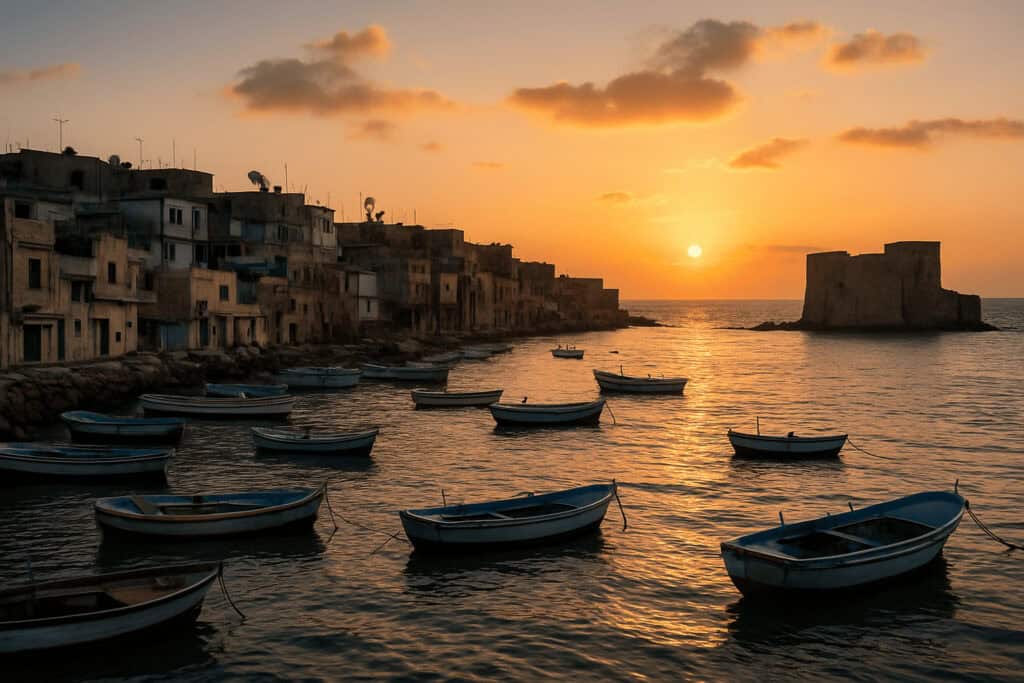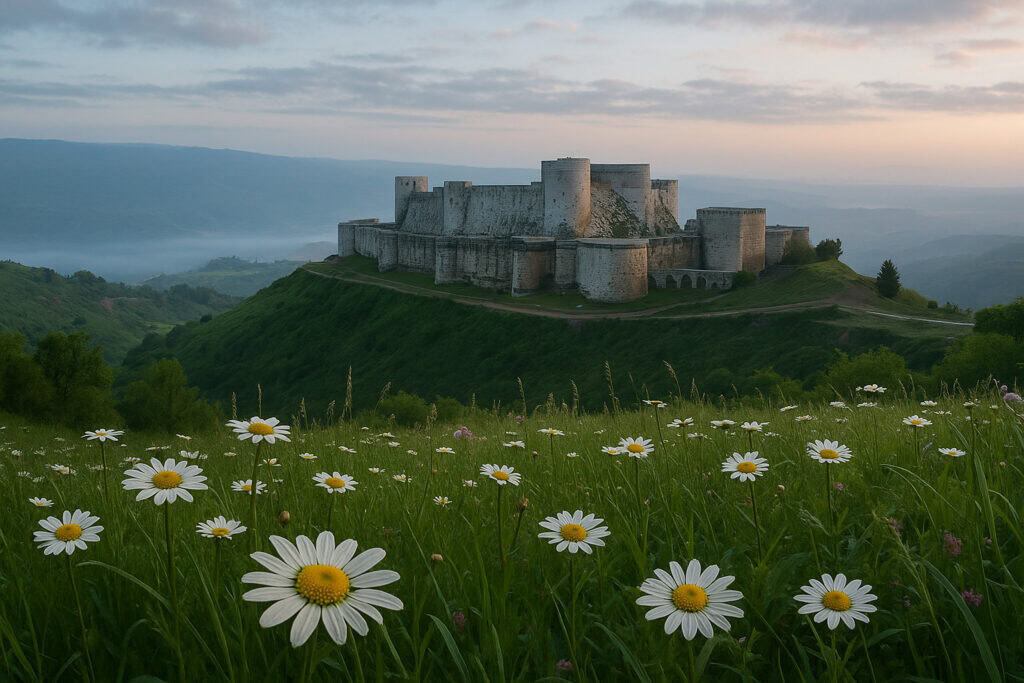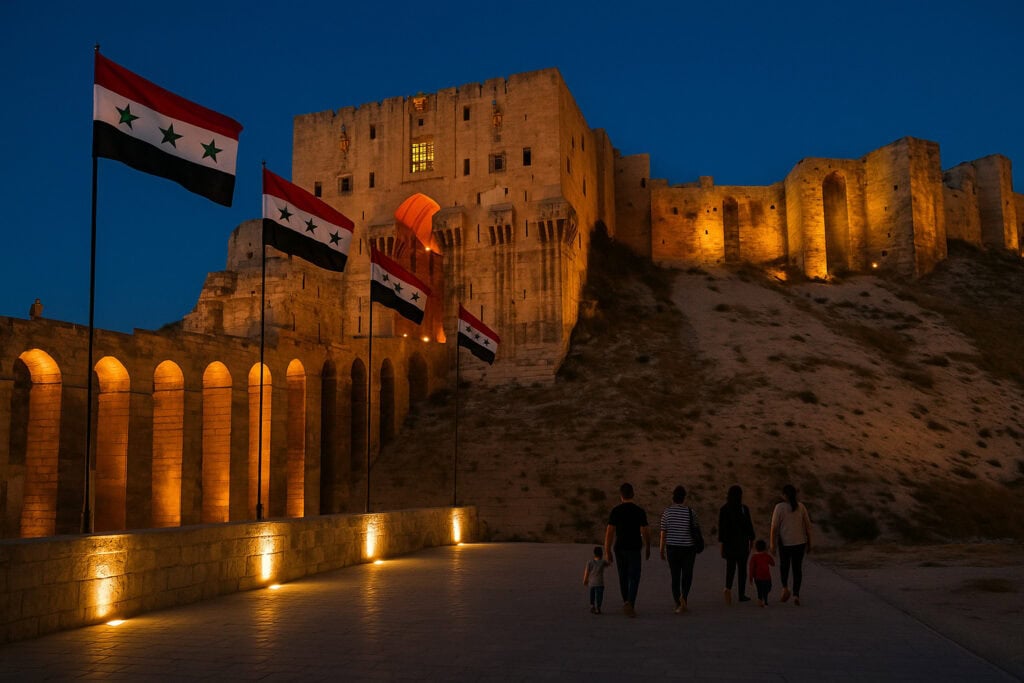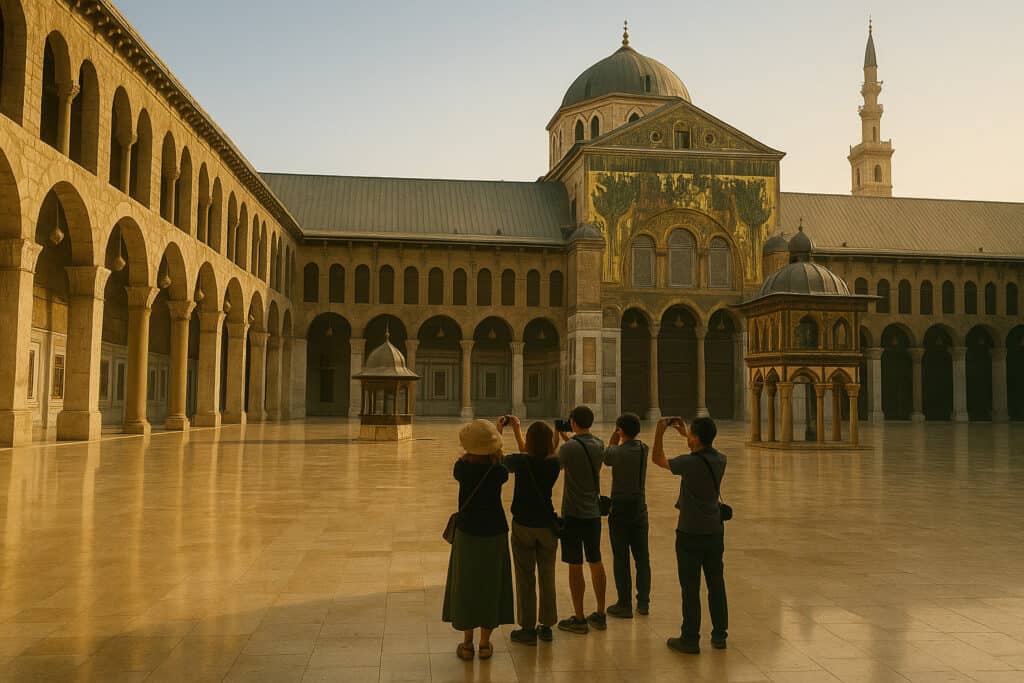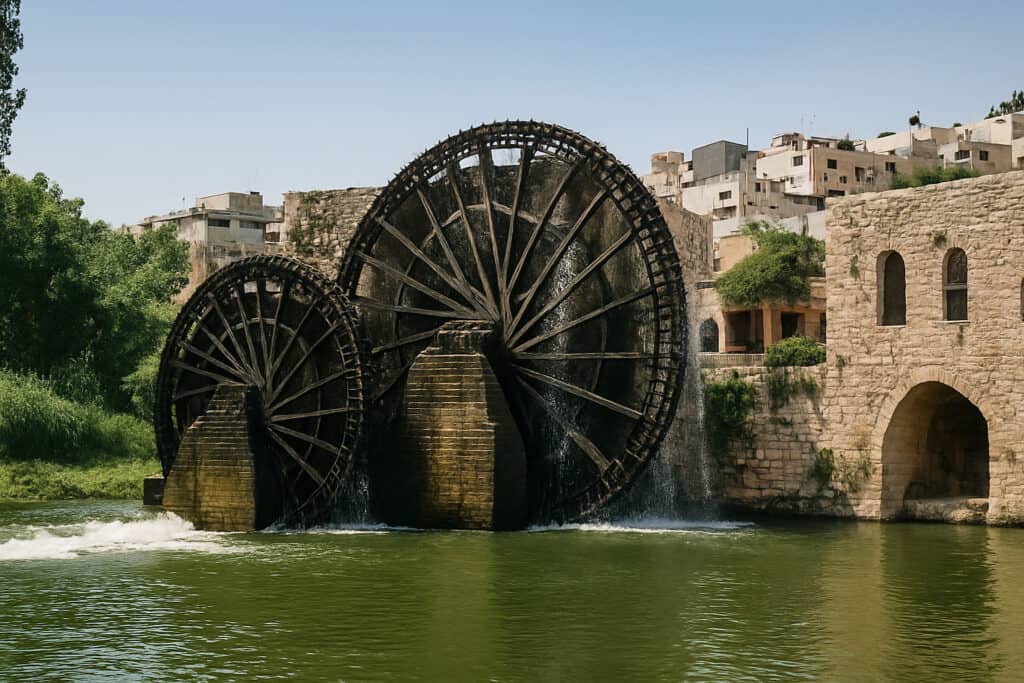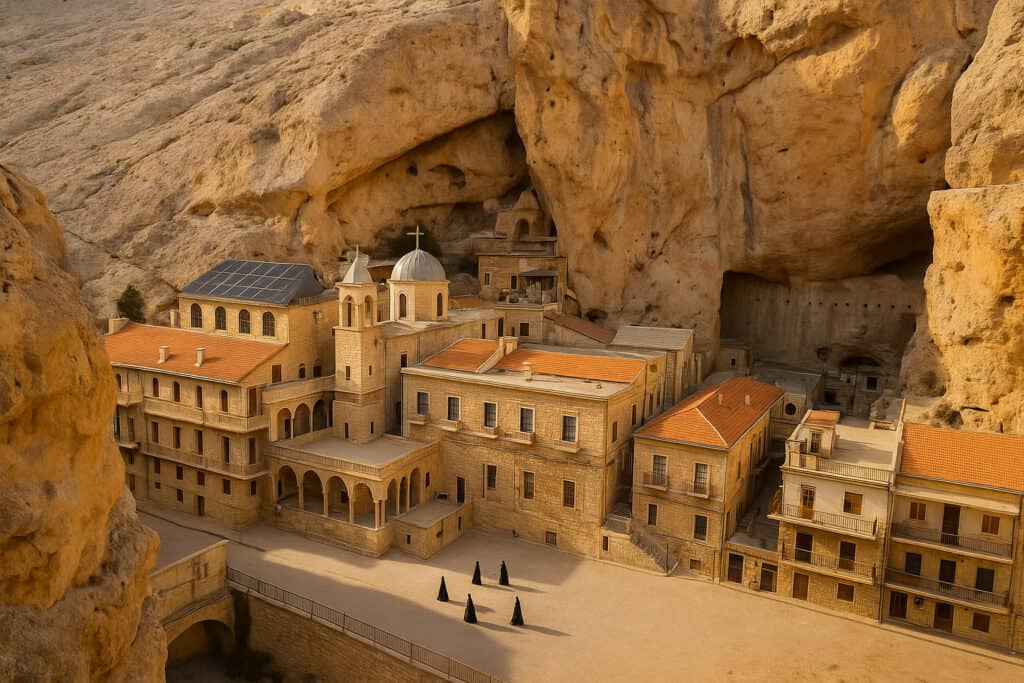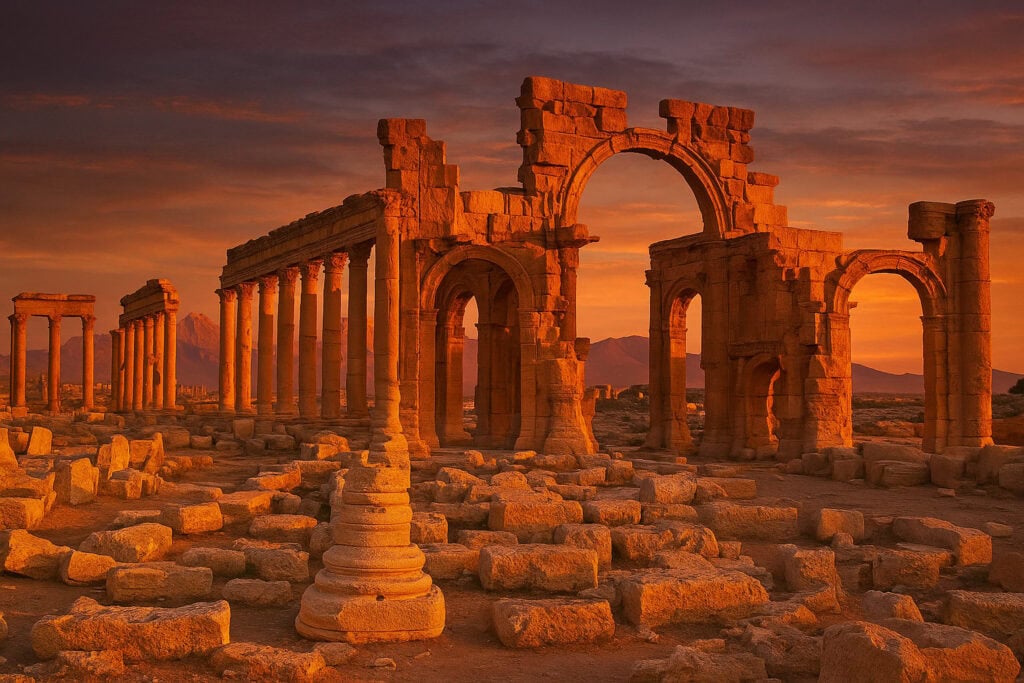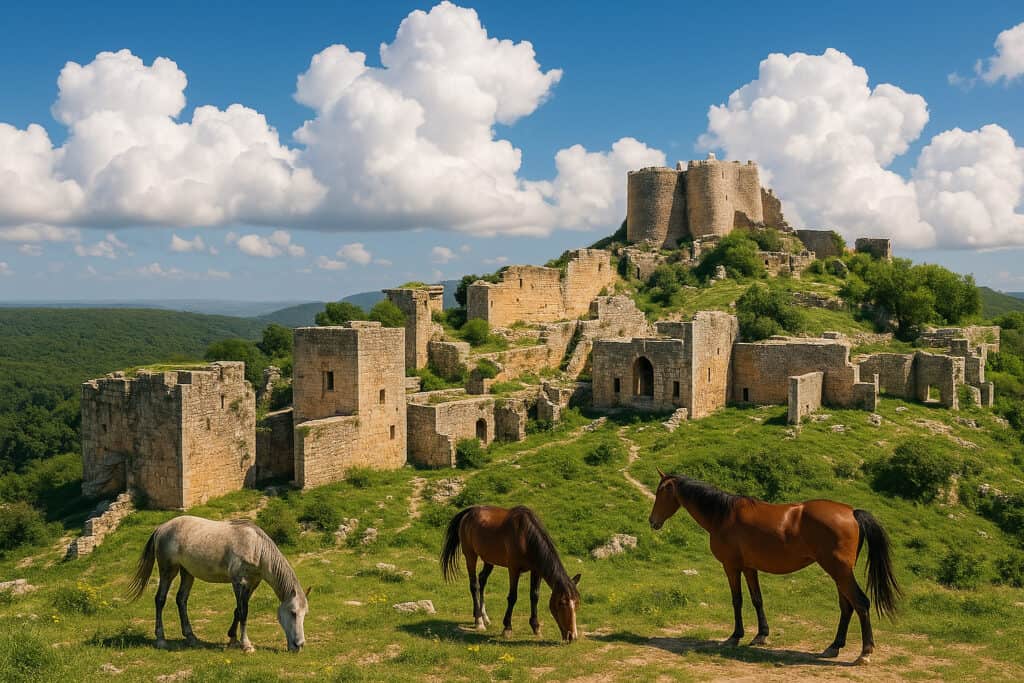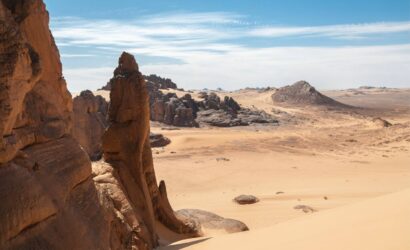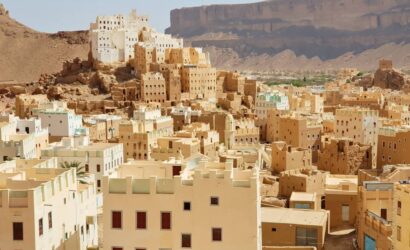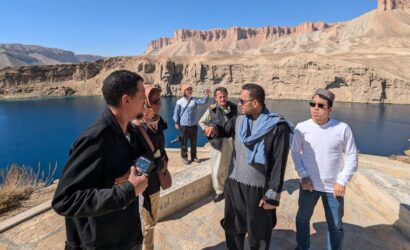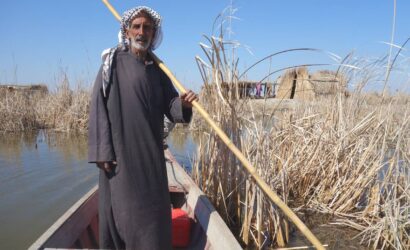The ultimate Syria overland expedition—from capital to coast, Crusader castles to Roman ruins, including remote temples, islands, and mountain towns.
Over 10 days, you’ll travel across Syria from Damascus to Aleppo and Palmyra, visiting ancient Roman cities, Crusader castles, early Christian villages, and Islamic landmarks still central to local life. Expect a deeply immersive experience combining archaeology, religion, everyday culture, and firsthand exposure to a country rebuilding from conflict.
⭐ Top 5 Highlights of the Tour:
- Travel from Beirut to Syria’s coast, visiting Arwad Island, Ugarit, and Tartous.
- Explore Tartous’ Amrit Temple and Safita’s Chastel Blanc, rarely visited Crusader sites.
- Tour Aleppo, Krak des Chevaliers, and Palmyra in one continuous route.
- Experience urban life and recovery in Damascus, Homs, and Aleppo post-conflict.
- Access diverse religious monuments, from Sayyidah Zaynab Shrine to Saint Thecla Convent.
Itinerary:
- Day 1 » 7am Beirut Morning pick-up » 9am Syrian Border » 11am Hotel check-in » 12pm Damascus (National Museum, Takiyya Suleimaniah Souq, Damascus Citadel, Mount Qasioun Viewpoint)
- Day 2 » Damascus (St Ananias Chapel, Church St.Paul, Zaitoun Church, Maktab Anbar, Khan Assad Basha Caravanserai, Al Azem Palace, Umayyad Mosque, Saladin Mausoleum, Sayyidah Ruqayya Shrine, Al-Hamidiyeh Souq)
- Day 3 » Damascus » Saidnaya Monastery » Maaloula (Church of Saints Sergios and Bacchos, Eastern Gorge hike, Saint Thecla Convent) » Mar Musa Monastery » Homs
- Day 4 » Homs (Um Al Zenar Church) » Hama (Al Jamea Alkabir, Saint George Cathedral, Norias) » Idlib (brief coffee and city center walk) » Aleppo
- Day 5 » Aleppo » Church of Qalb Lozeh » Aleppo (Khan Silk Souq, Old City, Aleppo Citadel, Armenian Forty Martyrs Cathedral, Soap Factory)
- Day 6 » Aleppo » Apamea ancient city » Salah Ed-Din Castle » Latakia
- Day 7 » Latakia » Ugarit ancient port » Markab Castle » Arwad Island » Tartous
- Day 8 » Tartous » Amrit Temple » Safita (Chastel Blanc) » Krak des Chevaliers Castle » Al-Mishtaya
- Day 9 » Al-Mishtaya » Palmyra ancient city » Damascus
- Day 10 » 8am Damascus departure » 9am Syrian Border » 12pm Beirut Drop-off
Travel to Syria 10-Day Classic Tour: Damascus Palmyra Aleppo
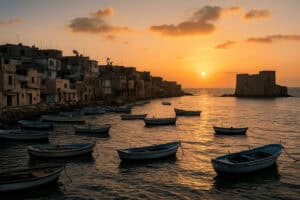
10-Day Syria Tour from Beirut Lebanon + English speaking guide + Airport-hotel pick up drop off + Tourist VISA reference number + Easy border crossing.
Product SKU: SYR10/BEY/BEY
Product Brand: RJ Travel - Tour Operator
-
Beirut
-
Beirut
-
3-star hotels with private bathroom and breakfast
-
SUV or Sedan
-
Included
-
Damascus, Palmyra, Aleppo, Krak des Chevaliers, Maaloula, Arwad Island, Qatna ancient city, Hama, Latakia, Salah ad-Din citadel, Ugarit, Marqab castle, Tartus , Homs, Bosra
-
Included
10-day Syria itinerary
Departure is scheduled for 7:00 AM from Beirut, heading east toward the Masnaa border crossing into Syria. After border procedures, arrival in Damascus is expected around 11:00 AM, followed by hotel check-in and a short rest before beginning afternoon visits.
The tour begins with the National Museum of Damascus, which contains artifacts spanning the prehistoric era to the Islamic period. Nearby, the Takiyya Suleimaniah Souq, built in the 16th century by Ottoman Sultan Suleiman the Magnificent, shows classical Ottoman urban architecture. You’ll then explore the Damascus Citadel, a fortified complex originally constructed by the Seljuks in the 11th century. To end the day, you'll drive up to Mount Qasioun, offering a panoramic viewpoint over the city and the Barada River valley.
This afternoon gives a first orientation to Syria’s capital through its archaeology, markets, and historic urban fabric.
Travel Distance & Time: Approx. 120 km – 3 hours (with border procedures)
Historical Context:
- Damascus Citadel was expanded under Saladin’s rule around 1174 CE.
- The National Museum holds statues from Mari, Ugarit, and Palmyra.
Curiosities & Local Facts:
- Takiyya Suleimaniah also houses a craft museum and prayer hall.
- Mount Qasioun is traditionally believed to be the place where Cain killed Abel.
5 Key Highlights:
- Cross-border transfer into Syria via Masnaa.
- First look at ancient Syrian civilization in the National Museum.
- Visit to an Ottoman-era religious-commercial complex.
- Walk through the fortified Citadel of Damascus.
- Sunset viewpoint from Mount Qasioun.
Important for you:
Damascus Citadel, Takiyya Suleimaniah, Mount Qasioun
Today begins with a full-day exploration of Damascus on foot and by vehicle, starting at 9:00 AM after breakfast. The tour enters the Christian Quarter, where you’ll visit the Chapel of Saint Ananias, an underground cave church said to be the home of Ananias who baptized Paul the Apostle. A short walk leads to the Church of Saint Paul, marking the spot where Paul escaped through the city wall.
Continuing through the Old City, you’ll visit Zaitoun Church, Maktab Anbar — a restored Ottoman-era mansion turned cultural center — and the 18th-century Khan As’ad Basha, the most elaborate caravanserai in the Levant. The itinerary then includes the Al-Azem Palace, an 18th-century residence showing Damascene architecture, before entering the Umayyad Mosque, one of the oldest and largest mosques in the world, constructed in 715 CE by the Umayyad Caliph Al-Walid I. Next door is the Mausoleum of Saladin, and finally the Sayyidah Ruqayya Shrine, important in Shi’a tradition, before a walk through Al-Hamidiyeh Souq.
This visit helps you see how history, religion, and daily life connect here in the heart of one of the world's oldest cities.
Travel Distance & Time: Local city tour – minimal driving.
Historical Context:
- The Umayyad Mosque sits on a former Roman temple and Christian basilica site.
- Maktab Anbar was completed in the 19th century under Ottoman rule.
Curiosities & Local Facts:
- The tomb of John the Baptist lies inside the Umayyad Mosque.
- Sayyidah Ruqayya Shrine is a center of Iranian pilgrimage in Damascus.
5 Key Highlights:
- Visit to Saint Ananias’ underground chapel and Paul’s escape site.
- Insight into Ottoman-era domestic life at Maktab Anbar.
- Exploration of the massive Khan As’ad Basha caravanserai.
- Guided entry to the Umayyad Mosque and Saladin’s tomb.
- Walking tour through the bustling Al-Hamidiyeh Souq.
Important for You:
Umayyad Mosque, Khan As’ad Basha, Sayyidah Ruqayya Shrine
Depart Damascus in the morning toward Saidnaya, home to a Greek Orthodox monastery believed to be founded by Emperor Justinian in the 6th century. The icon of the Virgin Mary housed here is considered miraculous by locals and pilgrims alike.
Next, continue to Maaloula, one of the last places where Western Aramaic is still spoken. Visit the Church of Saints Sergios and Bacchos, walk through the Eastern Gorge, and explore the Convent of Saint Thecla. Afterward, head to the remote Mar Musa Monastery, originally founded in the 6th century and restored in the 1980s. By evening, arrive in Homs for overnight.
This day shows how Christian communities have shaped the cultural and spiritual fabric of Syria.
Travel Distance & Time: Approx. 270 km – 5 hours drive
Historical Context:
- Saidnaya Monastery has Byzantine foundations and has operated continuously since the 6th century.
- Mar Musa was revived as an interfaith center by Jesuit priest Paolo Dall’Oglio.
Curiosities & Local Facts:
- Maaloula’s convent is an active pilgrimage site for both Christians and Muslims.
- Mar Musa blends Syriac architecture with sustainable practices.
5 Key Highlights:
- Icon worship at the highland monastery of Saidnaya.
- Walk the Aramaic-speaking village of Maaloula.
- Trail hike in the Eastern Gorge linked to Saint Thecla.
- Remote desert visit to Mar Musa Monastery.
- Arrival in Homs city.
Important for You:
Maaloula village, Saidnaya Monastery, Mar Musa Monastery
Begin the day in Homs with a visit to the Um Al-Zennar Church, named after the “belt” of the Virgin Mary preserved inside. Continue to Hama, where you’ll explore the Al Jamea Al Kabir Mosque, the Saint George Cathedral, and the iconic Norias — wooden waterwheels originally used for irrigation, some dating back to the 12th century.
From Hama, continue north to Aleppo, with a short stop in Idlib offers a brief coffee break and walk through the city center before reaching Aleppo for overnight stay.
This day helps connect Syria’s urban Christian-Muslim coexistence through religious and hydraulic engineering history.
Travel Distance & Time: Approx. 200 km – 3.5 hours drive
Historical Context:
- Um Al-Zennar Church is among the oldest Christian churches in the Levant.
- Hama’s norias were enhanced during the Ayyubid dynasty in the 12th century.
Curiosities & Local Facts:
- Hama’s norias once lifted water 20 meters from the Orontes River.
- The Grand Mosque of Hama was originally a Roman temple.
5 Key Highlights:
- Christian landmark visit in Homs.
- See ancient waterwheel technology in Hama.
- View historic mosque-cathedral juxtaposition in Hama.
- Observe Ayyubid hydraulic ingenuity.
- Coffee stop and orientation stroll in Idlib.
Important for You:
Um Al-Zennar Church, Hama Norias, Al Jamea Al Kabir
Start with a morning drive to the Church of Qalb Lozeh, a 5th-century Byzantine church in the Limestone Massif region, showcasing an early basilica layout that influenced Romanesque design. Return to Aleppo for a full afternoon tour.
Walk through the Old City, visiting the Khan al-Harir (Silk Khan) and Khan al-Saboun (Soap Khan). Enter the Aleppo Citadel, a fortified acropolis used since the Hellenistic period, with extensive Ayyubid and Mamluk reconstructions. Later, visit the Armenian Forty Martyrs Cathedral and a restored traditional soap factory.
You’ll walk through places that still carry the marks of past empires and local resilience.
Travel Distance & Time: Approx. 90 km – 2 hours drive
Historical Context:
- Qalb Lozeh Church dates from the 5th century and reflects early Syrian Christian architecture.
- Aleppo Citadel took its final form under the Ayyubids in the 12th–13th centuries.
Curiosities & Local Facts:
- The Forty Martyrs Cathedral serves Aleppo’s Armenian community, present since the 14th century.
- Traditional soap is made with olive oil and laurel oil.
5 Key Highlights:
- Morning visit to a landmark Byzantine church.
- Tour of Aleppo’s ancient commercial khans.
- Climb through the Aleppo Citadel fortifications.
- Learn traditional soap-making techniques.
- Discover Armenian heritage in Old Aleppo.
Important for You:
Aleppo Citadel, Qalb Lozeh Church, Forty Martyrs Cathedral
Depart Aleppo early to visit Apamea, a Roman-era city with a monumental colonnaded street and theater. Continue west to the mountainous Salah Ed-Din Castle, a Crusader fortress taken by Saladin in 1188, perched between two gorges and famous for its enormous moat carved from solid rock.
Arrive in Latakia, a Mediterranean coastal city, for overnight stay.
This day reveals how Roman urban planning and medieval fortifications shaped Syria's inland-to-coastal transition.
Travel Distance & Time: Approx. 280 km – 5 hours drive
Historical Context:
- Apamea was founded by Seleucus I in the 3rd century BCE.
- Salah Ed-Din Castle was once known as “Saône” during Crusader occupation.
Curiosities & Local Facts:
- The rock-cut moat at Salah Ed-Din is 28 meters wide and 20 meters deep.
- Apamea’s street had over 1,200 columns during its peak.
5 Key Highlights:
- Walk through Apamea’s Roman ruins.
- View the wide colonnaded avenue and theater.
- Explore Salah Ed-Din Castle’s defensive engineering.
- Scenic drive through forested mountains to the coast.
- Arrival in Latakia.
Important for You:
Apamea ruins, Salah Ed-Din Castle, Roman architecture Syria
Depart Latakia and visit Ugarit, the site of a Bronze Age port city where the earliest known alphabetic writing system (Ugaritic) was discovered. Excavations reveal palaces, temples, and residential quarters of a cosmopolitan trade hub dating back to the 14th century BCE.
Next, drive south to Markab Castle near Baniyas, a Crusader fortress perched above the sea, later refortified by Mamluks. Continue to Tartous, where you’ll take a short boat ride to Arwad Island, the only inhabited island in Syria, historically used by the Phoenicians and later Crusaders. Return to Tartous for overnight.
This day offers a rare look at both ancient alphabetic innovation and Syria’s maritime defense history.
Travel Distance & Time: Approx. 180 km – 4 hours drive (plus boat crossing)
Historical Context:
- Ugarit flourished between 1450–1200 BCE as a vassal to the Hittites and later Egypt.
- Arwad was a Phoenician naval base, later taken by the Knights Templar in the 13th century.
Curiosities & Local Facts:
- The Ugaritic script used 30 cuneiform signs and is a precursor to the Phoenician alphabet.
- Arwad’s narrow alleys and boatyards are still active today, mostly for fishing.
5 Key Highlights:
- Discover the ruins of Ugarit and the world's first alphabet.
- Clifftop views from Markab Castle.
- Boat ride to the only inhabited island in Syria.
- Walk through Arwad’s Crusader remnants and port town.
- Evening in coastal Tartous.
Important for You:
Ugarit site, Arwad Island, Markab Castle
After breakfast, make a short stop at the Amrit Temple, an open-air Phoenician ritual site dating to the 6th century BCE. It includes a unique water basin surrounded by carved stone altars. Then drive inland to Safita, where you'll visit the Chastel Blanc, a Templar tower still intact and in use as a church today.
In the afternoon, continue to Krak des Chevaliers, Syria’s most renowned Crusader fortress, built by the Hospitallers and later expanded by the Mamluks. Explore its towers, chapel, inner halls, and panoramic viewpoints. End the day with a short drive to Al-Mishtaya for overnight.
This stop gives context to how Crusader and Phoenician architecture coexisted and evolved in coastal Syria.
Travel Distance & Time: Approx. 130 km – 3.5 hours drive
Historical Context:
- Amrit was a Phoenician religious center affiliated with Arvad (Arwad).
- Krak des Chevaliers was a Crusader stronghold from 1142 until its fall to Baibars in 1271.
Curiosities & Local Facts:
- The Chastel Blanc still has functioning bells used during mass.
- Krak’s secret tunnel system was used to supply the castle during sieges.
5 Key Highlights:
- Visit to the ritual pools and altars of Amrit.
- Explore a Templar stronghold still used as a church.
- Detailed tour of Krak des Chevaliers’ defensive structures.
- Learn about Crusader-Mamluk military transitions.
- Stay overnight in a Christian mountain village.
Important for You:
Krak des Chevaliers, Chastel Blanc, Amrit Temple
Depart early for the desert to visit Palmyra, Syria’s most iconic ancient city and a UNESCO World Heritage Site. Known as the “Bride of the Desert,” it rose to prominence in the 1st–3rd centuries CE as a caravan city linking Rome and Persia. Visits include the Temple of Bel, Colonnaded Street, Tetrapylon, Funerary Towers, and the Roman Theater.
Though parts of the site suffered damage during recent conflicts, the scale of the remaining ruins still illustrates the city's imperial grandeur. After exploration, continue directly to Damascus for overnight stay.
This day highlights how desert trade routes once connected East and West through monumental urban design.
Travel Distance & Time: Approx. 330 km – 5 hours drive
Historical Context:
- Palmyra was annexed by Rome in 64 BCE and became a colony in 212 CE.
- Queen Zenobia ruled from Palmyra and led a revolt against Rome in 270 CE.
Curiosities & Local Facts:
- Some Palmyrene tombs contain multilingual inscriptions in Aramaic and Greek.
- The Tetrapylon was reconstructed during the French Mandate in the 1930s.
5 Key Highlights:
- Full visit to Palmyra’s Roman and local architecture.
- Stand in the remains of the Temple of Bel complex.
- View the theater and original Roman street grid.
- Learn about Zenobia’s brief empire.
- Return drive to Damascus.
Important for You:
Palmyra ruins, Temple of Bel, Queen Zenobia
The group departs from Damascus at 8:00 AM, heading west toward the Syrian–Lebanese border. After formalities and crossing, continue back into Lebanon, arriving in Beirut around 12:00 PM. Drop-off will be at the airport or hotel, marking the end of the journey.
This final segment completes your overland experience from the Mediterranean to the desert and back.
Travel Distance & Time: Approx. 120 km – 3.5 hours (including border procedures)
Historical Context:
- Masnaa is the main legal crossing point between Lebanon and Syria, open for travelers since antiquity.
Curiosities & Local Facts:
- The road between Damascus and Beirut follows part of the ancient Roman route to the coast.
5 Key Highlights:
- Morning departure from Syria.
- Cross-border transfer to Lebanon.
- Scenic drive through Anti-Lebanon Mountains.
- Arrival in Beirut before afternoon.
- Optional airport or hotel drop-off.
Important for You:
Syrian–Lebanese border, Beirut transfer, Damascus departure

